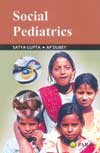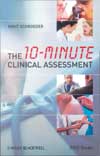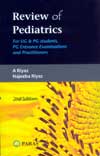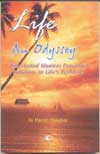|
|
|
Indian Pediatr 2011;48: 666-667 |
 |
Book Reviews |
|
 |
Social Pediatrics
Satya Gupta, AP Dubey
Paras Medical Publishers; Hyderabad, New Delhi
1 st
Edition, 2011
Pages: 387; Price: 250/-. |
Pediatricians, as an academic and professional
community, have always been responsive to their wider roles and it is not
merely a coincidence that they stay as some of the most visible and
suitably informed actors in the practice and politics of Public Health. In
this historical context, one feels a bit surprised that the domain of
Social Pediatrics did not enjoy a fitting growth rate inspite of the
exceptional legacy of leaders like Shanti Ghosh. This handy and readable
book comes as a booster while offering some consolidated and handy text to
the practitioners of pediatrics from varied settings. Uncomplicated mind
maps in most of its 33 chapters make the browsing very simple. It is
equally creditable that necessary theoretical and conceptual inputs have
not been sacrificed while maintaining a practical tenor. The flipside is
non-uniformity of form and structure amongst chapters, and a few unclear
photographs. Academic movements in Social Pediatrics have had a paroxysmal
character. A single book is a single vote which may not make or break the
establishments but one can hope that this attempt reignites a chain
reaction for some positive change.
Sanjay Chaturvedi
Professor of Community Medicine,
University College of Medical Sciences,
Delhi-110 095, India.
Email: [email protected]
|
 |
The 10 Minute Clinical Assessment - A Review
Knut Schroeder
UK: Wiley-Blackwell;
Pages: 772;
Price: Not mentioned. |
This ‘Desk Top’ reference Book consisting of 154
selected clinical situations is a treasure to be possessed by every
practitioner facilitating in making quick clinical assessment of the
patient’s illness based on the complaints and arrive at a correct
diagnosis for efficient management.
Though modern gadgets and sophisticated investigative
procedures are becoming abundant day by day, the importance of clinical
assessment cannot be underplayed. One of my professors during my
undergraduate training five decades ago, rightly said that "diagnosis of
respiratory system is by INSPECTION; diagnosis of gastrointestinal and
hepatic system diseases is by PALPATION; diagnosis of cardiovascular
diseases is by AUSCULTATION and diagnosis of central nervous neurological
disorders is by MATHEMATICAL CALCULATION". This book enlightens this maxim
in its well written and well presented 18 chapters. This book guides the
reader to assess the patient’s complaints and symptoms and signs in 10
minutes and arrive at a correct diagnosis for accurate management, and
refer if needed. This book guides the reader. I strongly recommend this
book for a practicing doctor’s office.
A Parthasarathy
Distinguished Professor of Pediatrics,
The Tamil Nadu Dr MGR Medical University,
Guindy, Chennai,
Tamil Nadu, India.
Email: [email protected]
|
 |
Approach to Practical Pediatrics
Manish Narang
Jaypee Brothers Medical Publishers 2011, New
Delhi.
Pages: 438, Price: Rs 399/-. |
This textbook reflects a simplified approach to
clinical cases in Pediatrics. The information is essential for
postgraduate clinical training, ward teaching rounds and preparation for
clinical examinations. A significant section of the book is presented in
the form of tables, flowcharts, algorithms and textboxes which makes the
presentation of the book impressive. The book is written in a simple
language and is reader friendly. Section 1 relates to commonly used
pediatric instruments, drugs, neonatal resuscitation, immunization and
antibiotic therapy. Section 2 and 3 pertain to the long and short cases in
pediatrics for summative evaluation. Section 4 includes invasive pediatric
procedures, X-rays, arterial blood gas interpretation, and national
health programs. The topics have been covered in a concise and informative
manner. Though the book is primarily written for postgraduate students are
useful for undergraduate students also. Future editions of the book should
contain more images and illustrations demonstrating clinical signs and
clinical maneuvers for better understanding. I recommend this book as a
ready reference material mainly for postgraduate students in pediatrics in
examination oriented preparation.
Sriram Krishnamurthy
Assistant Professor, Department of Pediatrics,
Jawaharlal Institute of Postgraduate
Medical Education and Research (JIPMER),
Puducherry-605 006, India.
Email: [email protected]
|
 |
Review of Pediatrics
A Riyaz and Najeeba Riyaz
Paras Medical Publishers 2011, Hyderabad.
Pages: 701; Price: Rs 350/- |
The authors, both senior academics, have compiled the
book based on their vast experience as teacher, examiner and their
clinical skill. The book is in the format of questions and answers.
Answers to the commonly asked questions in undergraduate and postgraduate
examinations are presented in a very lucid and simple manner. There are 19
chapters, presented in a unique fashion. The chapters on Radiology,
Dermatology and Ophthalmology are worth mentioning. The last chapter on
miscellaneous topics contains various clinical signs, tests, cells, triads
etc. It is an invaluable book especially just prior to clinical and theory
examinations and also viva. The book has been completely updated. It
contains several charts and tables. There are several mnemonics and tips.
The only drawback is lack of adequate number of figures. The book will be
very useful for undergraduate and PG students and medical college
teachers.
TM Ananda Kesavan
Associate Professor of Pediatrics,
Govt. Medical College,
Thrissur, Kerala,
India-680595.
Email: [email protected]
|
|
 |
Life an Odyssey
Manish Maladkar
Unicorn Books 2010, New Delhi,
Pages: 392; Price: 495/-. |
Human mind eternally seeks for solace in some sort of
metaphysical experience. This may not be evident for the materialist mind,
but is the same for all. Indian philosophy is replete with suggestions for
the need for such spiritual experience to make life complete or even
livable. Happiness is something we can attain by positive effort on our
part. Very same principle, in a more metaphysical way, is given by Dr
Manish Maladkar in his book. Each one of the 35 articles reflects a
particular aspect of life and the importance of being harmonious in social
existence. Oft repeated quotations make us familiar with thoughts of great
people, who continue to inspire us through centuries. Maladkar reminds us
that it does not matter what happens to us but what matters it what we do
about what happens. Nobody can make you unhappy without your consent. This
interesting book may be taken as a source book for meditative practice. It
needs more concentration and some sort of pensive mood. I doubt whether
happiness will be readily forthcoming from such books. Being happy or
unhappy is most often temperamental. If the book helps some to change
their temperament, the author would have succeeded. I will conclude this
review with another inspiring narration by Maladkar - God trying to solve
the problems of a man by giving him nectar of life in a golden pot, but he
sees only the gold and not the nectar. Hope this does not happen with this
book.
PNN Pisharody,
Pisharody’s Hospital,
Karunagappally,
Kollam 690 518, Kerala,
India.
Email: [email protected]
|
|
|
 |
|

